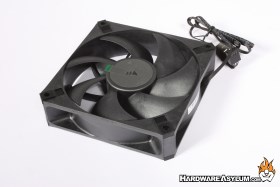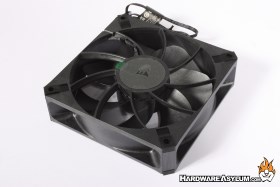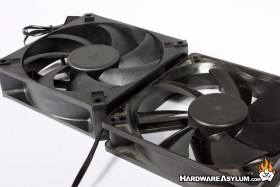Corsair RS120 MAX and RS140 MAX Fan Review
Author: Dennis GarciaIntroduction
During Computex 2024 I was introduced to a new concept in PC cooling, the 30mm fan. Computer fan size and thickness varied quite a bit in the early days. Industrial fans often were 35mm to 50mm thick and designed to move the maximum amount of air without compromise. Systems using these fans were often designed around the cooling device to save cost and lower manufacturing time. Early desktop computers followed the same concept but eventually a standard for 25mm thick fans was adopted for everything from CPU coolers, to Power Supplies and Case Fans.
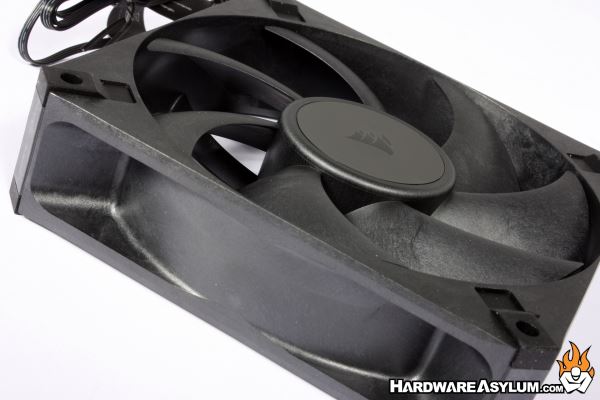
In this review we will be looking at the new RS120 MAX and RS140 MAX fans from Corsair. These are just basic PWM case fans, no RGB and no need for a fancy controller. Simply plug them in and away you go. The only major difference is that these are 30mm thick to take advantage of increase performance with an option to still remain silent.
Corsair sent over two packs of fans. The first is a three pack of 120mm x 30mm fans called the RS120 MAX. The second pack is a two pack of 140mm x 30mm fans called the RS140 MAX. Personally, I try to use 140mm fans in all of my builds and find it interesting that Corsair is matching the quantity against popular AIO radiator configs. 360mm radiators require 3x 120mm fans while the popular 280mm AIO only needs two 140mm fans. This is not so much a limitation of the AIO but, rather the case configuration supporting those coolers.
RS120 MAX
- Weight: 0.295
- Fan Size: 120mm x 30mm
- Fan Airflow: 16.5 - 72 CFM
- Fan Static Pressure: 0.22 - 4.2 mm-H2O
- Flow Type: STATIC PRESSURE
- Speed: 2000 RPM +/- 10%
- Sound Level: 29.5 dBA
- PWM Control: Yes
- Power Draw: 0.18A
- LINK Compatibility: None
- CORSAIR LINK compatibility: No
- Package Quantity: 1 / 3
- Fan Warranty: 5 Year
RS140 MAX
- Weight: 0.35
- Fan Size: 140mm x 30mm
- Fan Airflow: 27.5 - 104 CFM
- Fan Static Pressure: 0.2 - 2.4 mm-H2O
- Flow Type: STATIC PRESSURE
- Speed: 1600 RPM
- Sound Level: 31 dBA
- PWM Control: Yes
- Power Draw: 0.22A
- LINK Compatibility: None
- Package Quantity: 1 / 2
- Fan Warranty: 5 Year
From a high level most fans will appear to be the same, motor in the middle, spinny part to move air and a frame to hold everything together.
What I find interesting about the RS Max series is how blended the frame design is. From the outside we are presented with a geometric block, the corners are chamfered off while the open areas look to be machined away. Overall, this gives the fan an industrial look, is very dense and appears to be quite strong. This is reinforced by the overall weight of the fan giving you the assurance of quality.
I should also mention that the material is not standard ABS but rather the fibrous plastic used in structural design. It is called Glass Fiber Reinforced LCP (Liquid Crystal Polymer) and you don’t find many products made from this material mostly due to cost and weight concerns.
Flipping the fan over will expose the Corsair AirGuide Technology fins designed to redirect air into a column shape and provided more concentrated airflow directly below the fan. Combined with the High Static Pressure design makes these fans perfect for cooling high-density radiators and cases with restricted airflow.
The frame on the Corsair RS MAX fans is completely smooth with only a small gap between the fan blades and the frame. This location is where most of the fan noise is generated and also where you get air leaks when you have excessive backpressure.
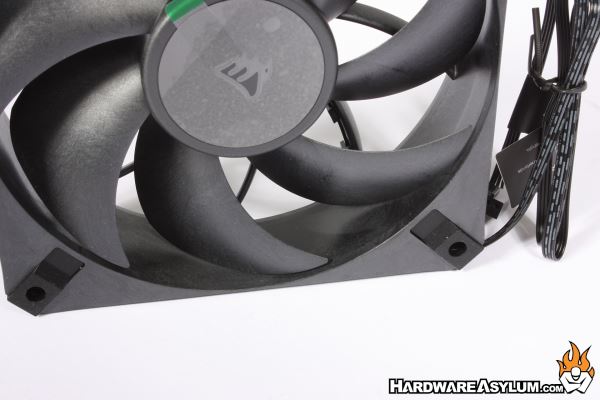
This is also where thicker fans can get more aggressive in their blade profiles to not only increase airflow and pressure but also minimize noise by reducing overall fan RPM. Under normal operation the Corsair RS Series was near silent but does get quite aggressive at higher speeds.
I do like the raised rubber vibration pads. These are only simple rubber blocks but go a long way at keeping the fan from moving around.
For those of you who are visual learners I have an interesting side by side. On the left we have the RS120 Max 120mm x 30mm fan. On the right is an early Corsair fan that was common on their Coolit Based AIO heatsinks. While the fan on the right is total garbage it does a good job at illustrating how far the RS Series has come in terms of design AND what an extra 5mm means in total fan thickness.
I've also included an expanded illustration showing many of the popular PC computer fan thicknesses.
While most of the mainstream system builders have fully adopted RGB designs in their builds there is a good number of us who what to keep things simple. Most RGB enabled fans are part of a company ecosystem making them difficult to control and often require specialized software to be installed and routed through a proprietary hardware controller. Just about every manufacture, including Corsair, has products like this but very few offer quality fans with a simple 4-pin PWM fan tail and nothing else.
This is where the Corsair RS Series is different. The fans are devoid of any RGB effects and feature a PWM motor with an RPM range between 425 and 2000rpm. Fan construction is also a little different from what you would normally expect featuring a fiber reinforced Liquid Crystal Polymer construction that is not only very dense but extremely strong to resist deformations and impacts. The PWM enabled fan features a magnetic dome bearing design to minimize noise and includes AirGuide technology for concentrated cooling.
As with most Corsair fans, these are extremely silent under normal operation but will actively wake up when needed with the 140mm RS Max offering up to 104CFM @ 1600rpm with a noise ceiling of 31dBA. Of course, this is made possible by the unique high-pressure blade design and 30mm thick fan profile.
While most computer fans standardized on a 25mm thickness that was done mostly to ensure compatibility. However, due to the popularity of AIO Watercoolers we have started to see a wider range of radiator thicknesses that has forced case makers to refined their designs. As a result, the 25mm thick standard no longer has the same implications and allows thicker fans like the Corsair RS Max series to simply slot in.
Good Things
Fiber Reinforced LCP Fan Construction
Available in Both 120mm and 140mm Sizes
ARGB Free Design
PWM Motor Design
Magnetic Dome Bearing
30mm Thick Fans
High Pressure Design
Fans can be a little heavy
Single fan tail adds time to cable routing



